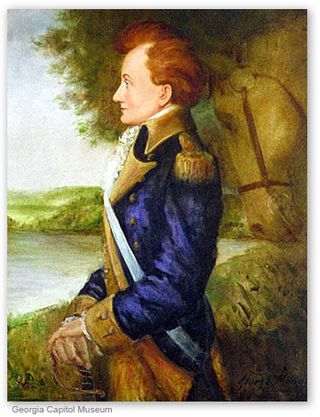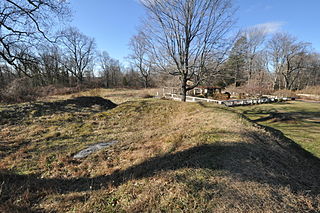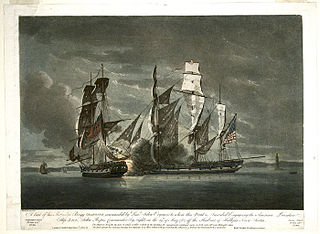Related Research Articles

The American Revolutionary War, also known as the Revolutionary War or American War of Independence, was a major war of the American Revolution. Widely considered as the war that secured the independence of the United States, fighting began on April 19, 1775, followed by the Lee Resolution on July 2, 1776, and the Declaration of Independence on July 4, 1776. The American Patriots were supported by the Kingdom of France and, to a lesser extent, the Dutch Republic and the Spanish Empire, in a conflict taking place in North America, the Caribbean, and the Atlantic Ocean.

Stephen Heard was an American planter, politician and military officer who briefly served as president of Georgia and was sometimes called "governor". Born in Virginia, Heard fought in the French and Indian War in the Virginia militia under George Washington, then with his father and brother moved to the Georgia colony based on a land grant for such service, and built two forts in Wilkes County called "Fort Heard". During the American Revolutionary War Heard served as a Lieutenant Colonel in the Georgia militia under Lieutenant John Dooly. He fought with Gen. Elijah Clarke at the Battle of Kettle Creek where he was captured but escaped. Voters elected Heard to the Georgia House of Representatives, where he served from 1779 to 1795. Heard's Fort was designated the seat of government for Georgia on February 3, 1780 and remained such until 1781, then developed into the town of Washington, Georgia. Fellow llegislators elected Heard as the state's executive, where he served from May 24, 1780, until August 18, 1781. One source records Heard as resigning as president in 1782.

The 1st Rhode Island Regiment was a regiment in the Continental Army raised in Rhode Island during the American Revolutionary War (1775–83). It was one of the few units in the Continental Army to serve through the entire war, from the siege of Boston to the disbanding of the Continental Army on November 3, 1783.

The 84th Regiment of Foot was a British regiment in the American Revolutionary War that was raised to defend present day Ontario, Quebec and Atlantic Canada from the constant land and sea attacks by American Revolutionaries. The 84th Regiment was also involved in offensive action in the Thirteen Colonies; including North Carolina, South Carolina, Georgia, Virginia and what is now Maine, as well as raids upon Lake Champlain and the Mohawk Valley. The regiment consisted of 2,000 men in twenty companies. The 84th Regiment was raised from Scottish soldiers who had served in the Seven Years' War and stayed in North America. As a result, the 84th Regiment had one of the oldest and most experienced officer corps of any regiment in North America. The Scottish Highland regiments were a key element of the British Army in the American Revolution. The 84th Regiment was clothed, armed and accoutred the same as the Black Watch, with Lieutenant Colonel Allan Maclean commanding the first battalion and Major General John Small of Strathardle commanding the second. The two Battalions operated independently of each other and saw little action together.

The Loyal American Regiment was a British Provincial regiment raised in 1777 for Loyalist service during the American Revolutionary War. The regiment fought in many engagements throughout the war and the men were among the thousands of loyalists who settled in Nova Scotia, after the regiment disbanded in 1783.

The Northern theater of the American Revolutionary War after Saratoga consisted of a series of battles between American revolutionaries and British forces, from 1778 to 1782 during the American Revolutionary War. It is characterized by two primary areas of activity. The first set of activities was based around the British base of operations in New York City, where each side made probes and counterprobes against the other's positions that sometimes resulted in notable actions. The second was essentially a frontier war in Upstate New York and rural northern Pennsylvania that was largely fought by state militia companies and some Indian allies on the American side, and Loyalist companies supported by Indians, British Indian agents, and occasionally British regulars. The notable exception to significant Continental Army participation on the frontier was the 1779 Sullivan Expedition, in which General John Sullivan led an army expedition that drove the Iroquois out of New York. The warfare amongst the splinters of the Iroquois Six Nations were particularly brutal, turning much of the Indian population into refugees.
The King's American Regiment, also known as the "Associated Refugees", were a Loyalist regiment during the American Revolutionary War.
The siege of Augusta took place between May 22, 1781, and June 6, 1781. American Patriot forces, led by General Andrew Pickens and Colonel Henry "Light Horse Harry" Lee, were successful in capturing Augusta, Georgia held by British loyalist militia. Fort Cornwallis, the primary British defence, was successfully exposed to cannon fire by the construction of a tower 30 feet (9.1 m) high on which the Americans mounted a small cannon. The British surrendered on June 6.

Associators were members of 17th- and 18th-century volunteer military associations in the British American thirteen colonies and British Colony of Canada. These were more commonly known as Maryland Protestant, Pennsylvania, and American Patriot and British Loyalist colonial militias. But unlike militias, the associator military volunteers were exempt from regular mandatory military service. Other names used to describe associators were "Associations", "Associated", "Refugees", "Volunteers", and "Partisans".

The Fort Stamford Site, site of Fort Stamford, is a public park at 900 Westover Road in the Westover neighborhood of Stamford, Connecticut. It was listed on the National Register of Historic Places in 1975. It is the site of the archaeological remnants of a military earthworks erected during the American Revolutionary War. The fort's location gave a clear view of the Mianus River and Long Island Sound.

The Battle of Fort Slongo was fought on October 3, 1781 between American Continental Army forces, under the command of Benjamin Tallmadge and Lemuel Trescott, and the British defenders of Fort Salonga, in the American Revolutionary War. The fort was located near the border of present-day Huntington Township and Smithtown, New York, overlooking Long Island Sound.
General John Campbell, 17th Chief of MacArthur Campbells of Strachur was a Scottish soldier and nobleman, who commanded the British forces at the Siege of Pensacola, and succeeded Guy Carleton, 1st Baron Dorchester as Commander-in-Chief in North America in 1783 following the end of the American War of Independence.

During the American Revolution, those who continued to support King George III of Great Britain came to be known as Loyalists. Loyalists are to be contrasted with Patriots, who supported the Revolution. Historians have estimated that during the American Revolution, between 15 and 20 percent of the white population of the colonies, or about 500,000 people, were Loyalists. As the war concluded with Great Britain defeated by the Americans and the French, the most active Loyalists were no longer welcome in the United States, and sought to move elsewhere in the British Empire. The large majority of the Loyalists remained in the United States, however, and enjoyed full citizenship there.

Colonists who supported the British cause in the American Revolution were Loyalists, often called Tories, or, occasionally, Royalists or King's Men. George Washington's winning side in the war called themselves "Patriots", and in this article Americans on the revolutionary side are called Patriots. For a detailed analysis of the psychology and social origins of the Loyalists, see Loyalist.
Major Moses Van Campen (1757–1849) was a soldier during the American Revolutionary War. He was a prominent figure in Pennsylvania and parts of New York. His primary involvement in the Revolutionary War was in fighting against hostile Native American tribes. He began work as a soldier in 1775 and retired from military service in 1783. Van Campen was familiar with Native American methods of warfare. He also participated in the Sullivan Expedition in 1779.

Brigadier General Francis McLean was a British army officer, one of two sons of Captain William Maclean and Anne Kinloch. He became famous for defending New Ireland (Maine) against the Penobscot Expedition during the American Revolution. The defeat of the Expedition was a noted British victory of the American Revolution. He was in command of the 74th Regiment of (Highland) Foot and 82nd Regiment of Foot (1778). He died 4 May 1781 at Halifax, Nova Scotia and is buried in the crypt of St. Paul's Church (Halifax). McLean never married.

John Bacon, was a leader of the Pine Robbers, a band of Loyalist guerrilla fighters who hid out in the Pine Barrens of south-central New Jersey and preyed upon Patriots toward the end of the American Revolutionary War. The group was responsible for the October 1782 Long Beach Island Massacre, which occurred after hostilities between the United States and Great Britain had been put on hold pending treaty negotiations. He and his band were relentlessly pursued thereafter. Bacon was killed the following March while resisting capture.

The Harbor Defenses of Long Island Sound was a United States Army Coast Artillery Corps harbor defense command. It coordinated the coast defenses of Long Island Sound and Connecticut from 1895 to 1950, beginning with the Endicott program. These included both coast artillery forts and underwater minefields. The area defended included the approach via the Sound to New York City, the port cities and manufacturing centers of New London, New Haven, and Bridgeport, and eventually included the submarine base and shipyard in Groton. The command originated circa 1900 as an Artillery District, was renamed Coast Defenses of Long Island Sound in 1913, and again renamed Harbor Defenses of Long Island Sound in 1925.

The Province of Nova Scotia was heavily involved in the American Revolutionary War (1776–1783). At that time, Nova Scotia also included present-day New Brunswick until that colony was created in 1784. The Revolution had a significant impact on shaping Nova Scotia, "almost the 14th American Colony". At the beginning, there was ambivalence in Nova Scotia over whether the colony should join the Americans in the war against Britain. Largely as a result of American privateer raids on Nova Scotia villages, as the war continued, the population of Nova Scotia solidified their support for the British. Nova Scotians were also influenced to remain loyal to Britain by the presence of British military units, judicial prosecution by the Nova Scotia Governors and the efforts of Reverend Henry Alline.
The Battle of Gwynn's Island saw Andrew Lewis lead patriot soldiers from Virginia against John Murray, 4th Earl of Dunmore's small naval squadron and British loyalist troops. In this American Revolutionary War action, accurate cannonfire from the nearby Virginia mainland persuaded Dunmore to abandon his base at Gwynn's Island. While camping on the island, the loyalists suffered heavy mortality from smallpox and an unknown fever, particularly among the escaped slaves that Dunmore recruited to fight against the American rebels. Gwynn's Island is located on the western shore of Chesapeake Bay in Mathews County, Virginia.
References
- ↑ Weigold, Marilyn E. (August 2004). The Long Island Sound: A History of Its People, Places, and Environment. ISBN 9780814794005.
- ↑ "Fort Franklin: Tory Bastion on Long Island Sound". 19 March 2015.
- ↑ "Loyalist Institute: Associated Loyalists & Others, Attack on Lloyd's Neck, 1781".
- ↑ Davidson, Stephen (August 2, 2009). "A Loyalist Refugee Camp". Loyalist Trails. United Empire Loyalists Association of Canada.